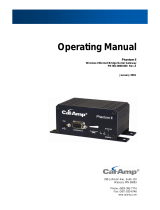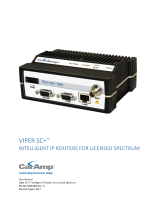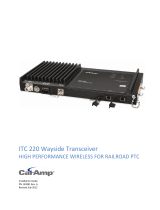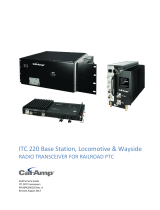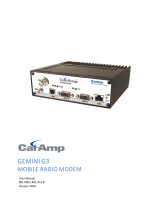Page is loading ...

Sentry 4G-900 Pico Base Station
Installation and Setup Guide
PN: 001-9290-001
Revision 0
June 2010

II
P
P
r
r
e
e
f
f
a
a
c
c
e
e
M
M
a
a
t
t
e
e
r
r
i
i
a
a
l
l
THE SPECIFICATIONS AND INFORMATION REGARDING THE PRODUCTS IN THIS MANUAL ARE SUBJECT TO CHANGE WITHOUT
NOTICE. ALL STATEMENTS, INFORMATION, AND RECOMMENDATIONS IN THIS MANUAL ARE BELIEVED TO BE ACCURATE BUT
ARE PRESENTED WITHOUT WARRANTY OF ANY KI ND, EXPRESSED OR IMPLIED. USERS MUST TAKE FULL RESPONSIBILITY
FOR THEIR APPLICATION OF ANY PRODUCTS.
THE
SOFTWARE LICENSE AND LIMITED WARRANTY FOR THE ACCOMPANYING PRODUCT ARE SET FORTH IN THE
INFORMATION PACKET SHIPPED WITH THE PRODUCT AND ARE INCORPORATED HEREIN BY THIS REFERENCE. IF YOU ARE
UNABLE TO LOCATE THE SOFTWARE LICENSE OR LIMITED WARRANTY, CONTACT YOUR CALAMP REPRESENTATIVE FOR A
COPY.
NOTWITHSTANDING
ANY OTHER WARRANTY HEREIN, ALL DOCUMENT FILES AND SOFTWARE OF THESE SUPPLIERS ARE
PROVIDED “AS IS”WITH ALL FAULTS. CALAMP AND ITS SUPPLIERS DISCLAIM ALL WARRANTIES,EXPRESSED OR IMPLIED,
INCLUDING,WITHOUT LIMITATION, THOSE OF MERCHANTABILITY, FITNESS FOR A PARTICULAR PURPOSE AND
NONINFRINGEMENT OR ARISING FROM A COURSE OF DEALING, USAGE, OR TRADE PRACTICE.
IN
NO EVENT SHALL CALAMP OR ITS SUPPLIERS BE LIABLE FOR ANY INDIRECT, SPECIAL, CONSEQUENTIAL, OR INCIDENTAL
DAMAGES,INCLUDING,WITHOUT LIMITATION,LOST PROFITS OR LOSS OR DAMAGE TO DATA ARISING OUT OF THE USE OR
INABILITY TO USE THIS MANUAL, EVEN IF CALAMP OR ITS SUPPLIERS HAVE BEEN ADVISED OF THE POSSIBILITY OF SUCH
DAMAGES.
COPYRIGHT
©2010 CALAMP. ALL RIGHTS RESERVED.
CALAMP
AND SENTRY 4G-900™ ARE REGISTERED TRADEMARKS OF CALAMP AND/OR ITS AFFILIATES IN THE U.S.AND
CERTAIN OTHER COUNTRIES.

Safety Information
General
Read this User Manual and follow all operating and safety instructions.
The base station and antennas must be installed by a professional installer.
The power requirements are indicated on the product-marking label. Do not exceed the
described limits.
Equipment Installation
The equipment should be installed in accordance with the National Electrical Code (NEC),
ANSI/NFPA 70, the Canadian Electrical Code (CEC), Part 1, CSA C22.1; and when applicable, the
National Electrical Safety Code IEEE C2. And unless marked or otherwise identified, the Standard
for the Protection of Electronic Computer/Data Processing Equipment, ANSI/NFPA 75.
RF Exposure
Sentry 4G-900 Pico Base Station is compliant with the requirements set forth in CFR 47 section
1.1307, addressing RF Exposure from radio frequency devices as defined in OET Bulletin 65. The
outdoor base station should be positioned more than 0.6 feet (20 cm) from humans. Lightning
Protection
When Sentry 4G-900 Pico Base Station unit is installed in an outdoor location, all indoor
components (Ethernet, power supply) should be connected through a lightning protector.
The purpose of the lightning protection is to protect people and equipment located indoors from
lightning that might strike the Sentry 4G-900 Pico Base Station unit or its outdoor cables.
Therefore, the lightning protector device should be installed indoors, as close as possible to the
point where the cables enter the building. The lightning protector can also be installed outdoors,
as long as the cables that go from it indoors are well protected from lightning between the box
and the building entrance.
Power Cord Protection
The Sentry 4G-900 Pico Base Station should always be connected to the supplied data adapter
for both power supply and data transfer purposes.
Any other type of connection/application of the Sentry 4G-900 Pico Base Station and/or supplied
data adapter is not allowed.
Route all power supply cords so that people cannot walk on them, or place objects on or against
them. This can pinch or damage the cords.
III

Servicing
Do not open the cover of this product and attempt service unless instructed by a CalAmp
certified technician. Refer all repairs to qualified service personnel. Removing the covers or
modifying any part of this device voids its warranty.
Keep away from electric power lines!
Carefully read and follow all instructions in this manual. By nature of the installation, you may be
exposed to hazardous environments and high voltage. Use caution when installing the outdoor
system.
Antenna Grounding Requirements
Verify that the antenna or cable system is grounded (earthed).
The antenna installation must be as per Article 810 of the NEC. Of particular note is the
requirement that the grounding conductor not be less than 10 AWG (Cu). The scheme should be
either in accordance with UL 96 and 96A. Lightning Protection Components and Installation
Requirements for Lightning Protection Systems, or tested in accordance with UL 50 and UL 497.
Outdoor Grounding System
Verify that the base station is grounded.
The system must be properly grounded to protect against power surges and accumulated static
electricity. It is the installer responsibility to install this device in accordance with the local
electrical codes.
Safety Hazards
Warning!
• Installing Sentry 4G-900 Pico Base Station can pose a serious hazard. Be sure to take
precautions to avoid the following:
• Exposure to high voltage lines during installation
• Falling when working at heights or with ladders
• Injuries from dropping tools
• Contact with AC wiring (power system connection)
Warning!
To reduce the risk of fire, only use a No. 24AWG or larger telecommunication line cord between
the indoor and outdoor units.
IV

V
Important Note:
This device complies with part 15 of the FCC Rules. Operation is subject to the following two
conditions: (1) This device may not cause harmful interference, and (2) this device must accept
any interference received, including interference that may cause undesired operation.
Changes or modifications not expressly approved by the party responsible for compliance could
void the user's authority to operate the equipment.
Note: This equipment has been tested and found to comply with the limits for a Class B digital
device, pursuant to part 15 of the FCC Rules. These limits are designed to provide reasonable
protection against harmful interference in a residential installation. This equipment generates,
uses and can radiate radio frequency energy and, if not installed and used in accordance with
the instructions, may cause harmful interference to radio communications. However, there is no
guarantee that interference will not occur in a particular installation. If this equipment does
cause harmful interference to radio or television reception, which can be determined by turning
the equipment off and on, the user is encouraged to try to correct the interference by one or
more of the following measures:
• Reorient or relocate the receiving antenna.
• Increase the separation between the equipment and receiver.
• Connect the equipment into an outlet on a circuit different from that to which the
receiver is connected.
• Consult the dealer or an experienced radio/TV technician for help.

About This Guide
This user guide provides essential product functionality with all the information necessary to
professionally install and configure the Sentry 4G-900 Pico Base Station.
This guide is intended for experienced technicians and operators. It is assumed that the
customers installing, operating and maintaining this product are familiar with WiMAX
technologies and procedures.
While some safety precautions are reviewed here, this manual assumes that installers have been
trained in safe installation practices. Users, who are new to WiMAX technologies and service
procedures, should not rely on this manual for comprehensive guidance.

List of Acronyms
ASN Access Service Network
CPE Customer Premise Equipment
FTP File Transfer Protocol
GW Gateway
HTTP Hypertext Transport Protocol
IDU Indoor Units
IEEE Institute of Electronic and Eclectic Engineers
IP Internet Protocol
LAN Local Area Network
LOS Line-of-sight
NMS Network Management System
ODU Outdoor Units
QoS Quality of Service
RF Radio Frequency
SLA Service Level Agreements
SNMP Simple Network Management Protocol
TCP Transmission Control Protocol
WiMAX Worldwide Interoperability for Microwave Access
VII

Table of Contents
Preface Material .......................................................................................................................... II
About This Guide ............................................................................................................................ VI
List of Acronyms ............................................................................................................................ VII
Table of Contents ........................................................................................................................ VIII
1 Introduction ........................................................................................................................ 10
1.1 About Sentry 4G-900 Pico Base Station ..................................................................................... 10
1.1.1 Main Features and Capabilities ........................................................................................ 11
1.2 System Architecture ................................................................................................................ 11
1.3 Interfaces ............................................................................................................................... 12
1.3.1 Bottom Panel ................................................................................................................. 12
1.3.2 Top Panel ..................................................................................................................... 13
2 Site and Installation Requirements .................................................................................. 14
2.1 Pico Base Station Installation Location ...................................................................................... 14
2.1.1 Criteria for Outdoor Locations ......................................................................................... 14
2.1.2 Criteria for Indoor Locations ........................................................................................... 14
2.1.3 Antenna Grounding Requirements ................................................................................... 14
3 Installation Procedure ....................................................................................................... 15
3.1 Pre-Installation Safety Instructions ........................................................................................... 15
3.2 Unpacking .............................................................................................................................. 15
3.3 Required Tools and Materials ................................................................................................... 16
3.4 Installing the Pico Base Station ................................................................................................ 16
3.4.1 Overview ...................................................................................................................... 16
3.4.2 Cover Console Port ........................................................................................................ 17
3.4.3 Assemble PoE Connector ................................................................................................ 17
3.4.4 Assemble Mounting Bracket ............................................................................................ 18
3.4.5 Mount the Pico Base Station ........................................................................................... 19
3.4.5.1 Wall Mount ........................................................................................................ 19
3.4.5.2 Pole Mount ........................................................................................................ 20
3.4.6 Antenna Connections ..................................................................................................... 21
3.4.6.1 RF Connections and Grounding ........................................................................... 21
VIII

IX
3.4.7
Connect the Pico Base Station Data Adapter ..................................................................... 22
4 Setup ................................................................................................................................... 24
4.1 Connecting Pico Base Station to Web Interface .......................................................................... 24
5 Troubleshooting ................................................................................................................. 26
5.1 No IP connectivity ................................................................................................................... 26
5.2 No Serial Connection ............................................................................................................... 26
Appendix A – Specifications .................................................................................................... 27
Appendix B – IDU to ODU Cable Specifications .................................................................... 28
Appendix C – Console Connector ........................................................................................... 29
Appendix D - Mechanical Drawing .......................................................................................... 30

10
1
I
I
ntroduction
ntroduction
1.1 About Sentry 4G-900 Pico Base Station
CalAmp Sentry 4G-900 Pico Base Station is a single sector station used to enhance outdoor and
indoor WiMAX coverage and capacity. The unit is easily installable, powered by PoE and supports
remote management.
The Sentry 4G-900 Pico Base Station provides full base station functionality necessary for serving
a single sector and operating in the 902-928 MHz ISM band. It supports up to 512 subscriber
units and its light weight and small footprint allow it to be easily mounted by one person on
poles, street lamps or walls.
The Pico Base Station is a broadband wireless access system based on the 802.16e mobile
WiMAX standard. Sentry 4G-900 systems are designed for robustness and simplicity, offering
feature-rich services with low deployment and operation costs, for unmatched operator
competitiveness and fast ROI.
The Pico Base Station provides all the functionality necessary to communicate with fixed and
mobile subscriber units according to the service criteria and customer Service Level Agreements
(SLA). The end-to-end Quality of Service (QoS) ensures the same high quality WiMAX experience
is delivered to customers outside or inside his/her home or small office.
Figure 1. Sentry 4G-900 Pico Base Station

11
1.1.1 Main Features and Capabilities
• All outdoor, one-box Pico Base Station solution
• GPS synchronization
• MIMO (2x2) support
• NLOS
• Small footprint and light weight enables simple installation and deployment by a single
person
• IEEE802.16e Wave2 Standard Compliance
• Backbone Ethernet connectivity via a 10/100 Base-T network interface
• Supports fixed and mobile CPEs
• Supports 3.5 MHz, 5MHz,7MHz and 10MHz channel bandwidth
• Traffic classification and connection establishment initiation
• Policy-based data switching
• Quality of Service (QoS) management
• Alarms management
• An SNMP agent incorporated into the unit enables extensive In-Band (IB) management of
the Base Station and all its registered CPEs
• R6 interface to ASN GW profile C
1.2 System Architecture
The Pico Base Station unit receives power and data over PoE.
Figure 2. Block Diagram
Pico Base
Station
PoE
Device

1.3 Interfaces
The unit is installed vertically, where the integrated GPS antenna is located on the
top panel
(
facing the sky). All other connections, including the optional GPS external antenna connections
are located on the
bottom
panel.
1.3.1 Bottom Panel
The interface panel supports the antenna, power and Ethernet connections.
GND
Figure 3. Pico Base Station Interface Panel
The following table provides a description of the Pico Base Station bottom panel connectors and
ports.
Table 1. Bottom Panel Connectors
No. Connector
Name
Connector
Type
Cable Type Description Connected to
1 ANT1 N type
Female
RG 214/U RF antenna connection external antenna or
Screwed-on omni-
directional antenna
2 Console RJ45 Cat5 ETH Low level CLI for CalAmp
technical personnel. RS-
232
Computer
3 DC + ETH RJ45 Cat5 ETH DC 1.5A + Ethernet Cat5 PoE data adapter
4 GND 1 screw
ETSI
#10 AWG bare
copper wire
Grounding lug. #10 AWG
bare copper wire
Central earth ground,
Tower or pole chassis
5 GPS
(optional)
TNC
Female
RG-59 Base Station
Synchronization
Optional External GPS
antenna
6 ANT2 N type
Female
RG 214/U RF antenna connection external antenna or
Screwed-on omni-
directional antenna
12

1.3.2 Top Panel
The top panel supports the built-in GPS antenna. (An external GPS antenna can be connected to
the bottom panel GPS connector). See section 2.1 for more information on GPS antennas and
installation criteria.
The figure below shows the Pico Base Station mounted on a pole.
Integrated GPS
antenna
Figure 4. Top panel GPS Antenna
13

14
2
S
S
ite
and
Installation
Requirements
ite and Installation Requirements
2.1 Pico Base Station Installation Location
WARNING!
THE PICO BASE STATION UNIT MUST ALWAYS BE INSTALLED VERTICALLY AND TOP-DOWN –
WITH THE CONNECTORS ON THE UNDERSIDE FOR PROTECTION.
This section describes the criteria that should be considered when selecting the Pico Base Station
installation location.
2.1.1 Criteria for Outdoor Locations
Take into account your site plan and local regulations that define distance from populated areas.
• The unit should be mounted in the highest possible point. Reception will increase according
to the height of the antennas.
• There should be minimum obstacles between the antenna and the planned coverage area
(zone) – minimum of 55% exposure to the sky.
• Take into account (according to your coverage site plan) distance from other antennas or
devices that may cause interferences.
• Accessibility for maintenance (where possible).
2.1.2 Criteria for Indoor Locations
• A minimum of 55% direct LOS exposure of the external GPS antenna to sky.
• Maximum distance between external GPS antenna to Pico Base Station = 22 meters.
2.1.3 Antenna Grounding Requirements
The antenna installation must be as per Article 810 of the NEC. Of particular note is the
requirement that the grounding conductor not be less than 10 AWG (Cu). The scheme should
either correspond to UL 96 and 96A. Lightning Protection Components and Installation
Requirements for Lightning Protection Systems, or tested in according to UL 50 and UL 497.

15
3
I
I
nstallation
Procedure
nstallation Procedure
3.1 Pre-Installation Safety Instructions
Warning!
Before installing the Pico Base Station, review the following safety hazards:
• Installing Pico Base Station can pose a serious hazard. Be sure to take precautions to
avoid the following:
• Exposure to high voltage lines during installation
• Falling when working at heights or with ladders
• Injuries from dropping tools
• Contact with AC wiring (power system connection)
3.2 Unpacking
Upon receiving the Pico Base Station unit, perform the following:
1. Examine the shipping container for damage before unpacking the unit.
2. Perform a visual inspection to reveal any physical damage to the equipment.
Note: In case of damage, contact the shipping company.
3. Verify that all of the equipment (listed below) is included. Otherwise contact CalAmp.
4. The Pico Base Station is shipped with the following equipment:
• Sentry 4G-900 Pico Base Station.
• Integral 2 x omni-directional antennas
• Data adapter including Power Supply.
• Internal GPS receiver and integrated GPS antenna
• Pico Base Station pole/wall mounting bracket.
• Cat5 Serial cable (2m) for the console connector of the Pico Base Station (cable
connectors: DB9F, RJ45)
Note: The connection between the Pico Base Station to the data adapter is performed by a
standard outdoor Cat5E shielded Ethernet cable. The Ethernet cable is not supplied.
• Metal bands x 2 for mounting on poles
• Screws, springs and washers x 4

3.3 Required Tools and Materials
In order to install the Pico Base Station, a standard professional toolbox is required.
3.4 Installing the Pico Base Station
Note: Should be installed at highest possible point!
Important!
The equipment should be installed in compliance with the National Electrical Code (NEC),
ANSI/NFPA 70, the Canadian Electrical Code (CEC), Part 1, CSA C22.1; and when applicable, the
National Electrical Safety Code IEEE C2. Unless marked or otherwise identified, the Standard for
the Protection of Electronic Computer/Data Processing Equipment, ANSI/NFPA 75.
There are two types of installations for the Pico Base Station:
• Wall mount - The Pico Base Station can be attached to any wall that can support the load
of the unit.
• Pole mount - The unit can be attached to any pipe or pole with diameter 1.75” to 10".
3.4.1 Overview
The Pico Base Station installation procedure consists of the following steps:
1. Covering the Console port (only used for maintenance purposes by authorized personnel) –
see 3.4.2.
2. Assembling the PoE connector – see 3.4.3.
3. Assembling the Pico Base Station mounting bracket – see 3.4.4.
4. Mounting the Pico Base Station (wall/pole mount) – See 3.4.5.
5. Antenna connections and grounding – see 3.4.6.
6. Connecting the Pico Base Station Data Adapter – see 3.4.7.
7. See chapter 4 for the initial Setup procedure.
16

3.4.2 Cover Console Port
The Console port is only used for maintenance operations performed by authorized service
personnel and should be closed in normal conditions.
Secure the Console port with both of the (supplied) screws to the port panel. See figure below.
Note: See Appendix C – Console C for Console cable pin out.
3.4.3 Assemble PoE Connector
The DC/Ethernet connector that provides the PoE connection must be assembled as follows:
1. Insert the cap in to the DC/Ethernet port cover, with the as shown below.
2. Insert the PoE cable (not supplied) through the cap and connect it to the supplied J45
connector.
3. Snap the J45 connector into the DC/Ethernet opening.
17

4. Align the cap ridge with slot in port and insert both screws into the cover screw holes and
insert in to corresponding screw holes located at the top-left and bottom-right of the
DC/Ethernet port.
5. Tighten the screws and secure cover to port.
3.4.4 Assemble Mounting Bracket
To assemble the mounting bracket on the Pico Base Station unit
1. Align the mounting brackets’ four inner holes with the Pico Base Station installation holes,
located on the under-side of the unit (rib-side). See figure below.
2. Using a Phillips screwdriver, secure the bracket to the Pico Base Station unit with the four
screws and washers (supplied).
18

3.4.5 Mount the Pico Base Station
3.4.5.1 Wall Mount
Note: The Pico Base Station can be attached to any wall that can support the load of the unit.
To mount the unit on the wall
1. Determine the location of the Pico Base Station mounting bracket and mark the drilling holes
on the wall surface based on the brackets’ four (outer) mounting holes (two at the top and
two at the bottom).
Mounting holes x 4
PLAN THE INSTALLATION SO THE INTERFACES FACE DOWN- PROVIDING MORE
PROTECTION AGAINST THE ELEMENTS.
2. Drill the four holes in the wall and align the bracket installation holes with the holes in the
wall. Secure with the appropriate screws and washers (not supplied).
19

3.4.5.2 Pole Mount
Note: The unit can be attached to any pipe or pole with a 1.75” to 10" diameter.
To mount the Pico Base Station on a pole
1. Assemble the wall-mounting bracket to the rear side of the unit (rib-side) – see 3.4.2.
2. Insert the metal bands in the bracket slots, as shown below.
3. Mount the unit on the pole, using the metal bands and close the bands tightly around the
pole.
4. Secure the metal bands with their screws. See following figure.
Pole mounted
Pico Base
Figure 5. Pole Mount
20
/

